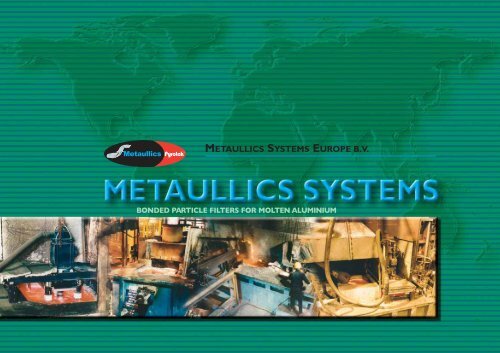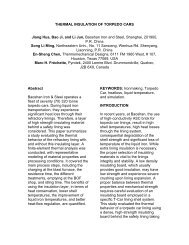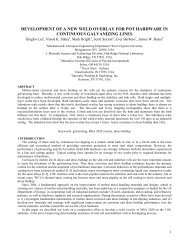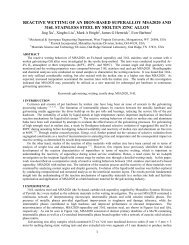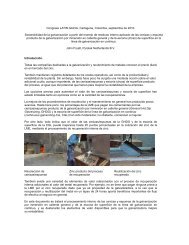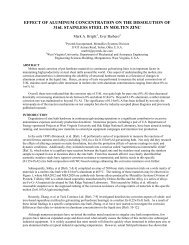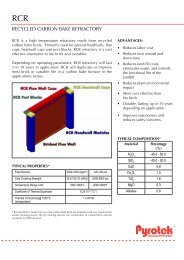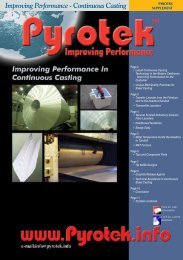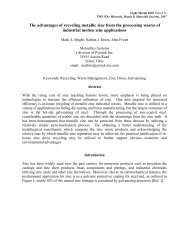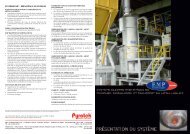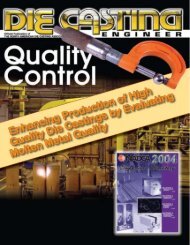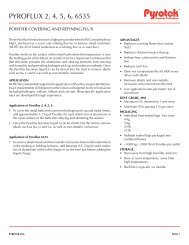Bonded Particle Filter - Pyrotek
Bonded Particle Filter - Pyrotek
Bonded Particle Filter - Pyrotek
Create successful ePaper yourself
Turn your PDF publications into a flip-book with our unique Google optimized e-Paper software.
BONDED PARTICLE FILTERS FOR MOLTEN ALUMINIUM
METAULLICS SYSTEMS<br />
Metaullics Systems, headquartered in Solon, Ohio, USA is a<br />
division of <strong>Pyrotek</strong>, Inc., which is a privately owned company with<br />
headquarters in Spokane,Washington, USA.<br />
<strong>Pyrotek</strong> specialises in the development, manufacture and supply of<br />
high temperature materials, technologies and engineered systems<br />
for liquid metal management and associated metallurgical<br />
applications. Manufacturing units and sales offices are located in<br />
more than 60 worldwide locations and allow <strong>Pyrotek</strong> to offer<br />
outstanding customer service and supply logistics. Products<br />
include launder systems, distribution bowls, tundishes and<br />
specialised insulating shapes and filters.<br />
Metaullics is a global supplier of molten metal pumps, distribution<br />
systems, alloying systems and scrap and waste recovery systems,<br />
filtration systems for all sectors of the Aluminium industry.<br />
Metaullics Systems Europe, with headquarters in The Netherlands<br />
provides local application engineering, customer service and<br />
warehousing facilities for Europe and The Middle East.<br />
1. SUPERIOR FILTER MEDIA<br />
FROM METAULLICS<br />
It gives you the benefits of clean aluminium – reliably and<br />
economically.<br />
Molten aluminium normally contains various solid-phase<br />
inclusions, such as oxides, borides, carbides and spinels, and<br />
refractory particles from vessel erosion. If allowed to remain,<br />
these contaminants adversely affect the characteristics of the<br />
metal in its final, solidified form.<br />
Impact of Inclusions on Final Product Quality<br />
Reduced extrusion die life<br />
Surface streaks<br />
in bright<br />
automotive<br />
trim<br />
Poor<br />
surface<br />
finish<br />
Flange<br />
cracks in<br />
beverage cans<br />
Inclusion<br />
Generated<br />
Defects<br />
Reduced mechanical strength, ductility, fatige resistance<br />
Effective filtering of molten (liquid) aluminium removes these<br />
contaminants and can also reduce inclusion-nucleated porosity.<br />
This not only improves product quality and lowers the reject rate,<br />
creating additional profit to cover the cost of filtration. In fact,<br />
filtration always adds value—never just cost!<br />
However, with some commercially available filters, problems like<br />
rapid head build-up, sudden contaminant release (dumping), filter<br />
breakage and even ineffective or unreliable filtration can occur.<br />
Precaution requires the use of superior media, plus special know-<br />
how and applications expertise to lower the effective cost of<br />
aluminium filtration and achieve maximum benefit.<br />
Poor machine<br />
ability<br />
Reduced<br />
brightness<br />
in<br />
anodised<br />
products<br />
Pinholes in<br />
light<br />
gauge foil
At Metaullics, we analyse your process in detail. Only then can we<br />
determine the correct filter and specify the proper shape, size and<br />
permeability for your specific application. Once this has been<br />
done, you can expect trouble-free service life from your<br />
Metaullics® filters.The media we use, bonded ceramic particulate,<br />
provides high filtration efficiency and excellent structural strength.<br />
Our media is used in selected wrought casthouse applications to<br />
produce semi-finished shapes, and in aluminium gravity casting<br />
(permanent mold), pressure diecasting, low pressure, squeeze cast<br />
and high-performance sand foundries.<br />
Because filtration of aluminium is a complex subject, we hope the<br />
information in this brochure will prove useful. Let’s begin with a<br />
look at what effective filtration should accomplish for you<br />
1.1 INCLUSIONS TO BE REMOVED<br />
Filtration is the separation of solids from liquids. Effective filtration<br />
should trap and hold the major contaminants that are commonly<br />
found in molten aluminium. Oxides of aluminium and magnesium<br />
are among the inclusions most frequently encountered. Of these<br />
Al2O3 is the most troublesome, because it is the most easily<br />
formed, hence, the most abundant. Furthermore, many inclusions<br />
have an effective specific gravity close to that of molten aluminium<br />
and tend to stay in suspension. Spinel, another kind of<br />
contaminant, is a complex oxide with a specific crystal structure<br />
and the general chemical formula of AB2O4 where A and B are<br />
metals. Common examples of spinels are MgAl2O4 and MnAl2O4.<br />
Other inclusions to be found include carbides (especially from<br />
primary aluminium production), nitrides, and refractory particles<br />
from wear and erosion. In foundry alloys, especially diecasting<br />
metal, intermetallic sludge particles (Fe-Mn-Cr complex) can<br />
cause ‘hardspots’ which cause machining difficulty. Additionally,<br />
recycled metal in any remelt operation always contains substantial<br />
oxide content
2. DEPENDABLE METAL CLEANLINESS WITHOUT PROBLEMS<br />
DEMANDS DEPENDABLE FILTER MEDIA<br />
2.1 WHAT FILTERING DOES FOR METAL QUALITY<br />
When effective, filtration substantially improves product unifor-<br />
mity. Figure 1a and 1b show the difference between a filtered and<br />
an unfiltered aluminium foil product.<br />
Figure 1a.<br />
Unfiltered aluminium<br />
foil product metal<br />
at 350X.<br />
Figure 1b.<br />
Foil alloy filtered<br />
through 10 grit<br />
Multicast<br />
MC-6 filter.<br />
Magnification 350X.<br />
<strong>Filter</strong>ing the molten metal results in significantly increased fluidity,<br />
which improves castability and helps to prolong mold life.<br />
Since inclusions, or hard spots, are minimised or eliminated, the<br />
metal is easier to form or machine and tool wear is reduced.<br />
With fewer casting defects, your yield and productivity are higher,<br />
as is overall product quality.<br />
Mechanical properties (tensile, yield, fatigue, creep and rupture<br />
strength) can often be improved with filtration, but elongation<br />
or ductility is especially sensitive to metal cleanliness, i.e. low<br />
inclusion levels achieved with filtration means higher ductility. For<br />
example, in extrusion billet casting, as shown in figure 2, the<br />
percentage of elongation can be greatly increased, even doubled in<br />
some cases.<br />
Improved surface finish results from inclusion removal, important<br />
for bright trim stock, cast wheels, or for any other surface finishing<br />
operations (anodizing, painting and plating). Filtration also reduces<br />
the rate of rejection and rework due to pinholes, linear defects or<br />
tear-out in foil and sheet product production.<br />
Figure 2.<br />
Effect of filtration on<br />
short transverse<br />
elongation of 7079-T6.
Filtration is especially beneficial in removing ‘hardspots’ (oxide and<br />
sludge inclusions) from net and near-net-shape foundry castings,<br />
resulting in significantly increased machinibility, less tool wear<br />
and less tool breakage! Clearly, gains in product quality, productivity<br />
and profitability make filtration a very necessary and desirable<br />
process for all aluminium casting applications.<br />
2.2 COMMERCIALLY AVAILABLE FILTER MEDIA<br />
Four major types of filters for aluminium are found in the<br />
marketplace. Along with their predominant characteristics, they<br />
are the following:<br />
A. Alumina bed filters<br />
Bed filters are comprised of ‘layers’ of tabular and ball alumina to<br />
create ‘depth’ as the metal flows between the ‘balls’ and flakes.<br />
The porosity of the bed is not fixed, however, so channelling of the<br />
aluminium flow can occur, either spontaneously through surge<br />
flow, or inadvertently through mechanical disturbances. This can<br />
lead to dumping of already-trapped inclusions and discharge of<br />
unfiltered metal. While deep-bed filters are usually large and fairly<br />
costly, they do provide excellent filtration if the life is not over-<br />
extended.<br />
B. Ceramic foam filters<br />
Ceramic foam filters are bonded or sintered alumina with<br />
porosity controlled during manufacture to provide a gradation<br />
of pore sizes 20 or 30 ppi, or grades 40, 50, 60, 65 and 80. With<br />
high average porosity (80-85%), fairly rapid metal flow rates can be<br />
achieved, but at the expense of filtration efficiency. With such high<br />
porosity, mechanical strength is relatively low, and handling<br />
damage or break-up may occur during melt flow. Providing the<br />
proper filter grade/flow relationship is maintained for an initial<br />
metal cleanliness, ceramic foam filters are low-cost and find their<br />
best application as a single-use (single-cast) application in the<br />
casthouse or foundry.<br />
C. <strong>Bonded</strong> ceramic particles<br />
This is the type of filter supplied by Metaullics - a bonded granular<br />
ceramic media, fabricated either from aluminium oxide or silicon<br />
carbide. The proprietary bonding agent employed is both strong<br />
and resistant to chemical attack by molten aluminium.<br />
Substantially lower porosity (nominally 40%) and the inherent<br />
properties of the hard alumina or silicon carbide granules<br />
provides a much stonger filter structure which aids in handling<br />
and durability. Especially with silicon carbide construction, thermal<br />
conductivity is substantially higher which aids in preheat and in<br />
thermal transfer. The complex, fully-interconnected internal pore<br />
structure provides a ‘tortuous path’ for metal flow. The bonding<br />
agent also has a particular affinity for inclusions. This combination<br />
of lower porosity, tortuous flow path and binder chemistry allows<br />
the Metaullics bonded particle filter to exhibit the best balance<br />
between cake-mode and depth-mode filtration.
D. Other filter media<br />
In addition to the preceding filter types, woven fiberglass and<br />
extruded ceramics may be used to filter aluminium.<br />
Non-rigid fiberglass socks or screens provide very coarse<br />
filtration through a sieve-like action. Inexpensive, they are used<br />
primarily as a coarse pre-filter after a taphole or where neces-<br />
sary to remove only the largest contaminants.<br />
Extruded ceramics have direct-channel openings where the outlet<br />
area is the same as the inlet area. Accordingly, they are used more<br />
for flow control and removal of large inclusion particulate, but are<br />
not very effective for many of the smaller but still undesirable<br />
inclusions often existing in aluminium melts.<br />
Figure 3 compares the features of the various filter types:<br />
High<br />
Temperature<br />
Strength<br />
Geometric<br />
Shapes<br />
Available<br />
Coarse<br />
Filtration<br />
Fine<br />
Filtration<br />
Thermal<br />
Conductivity<br />
Resistance<br />
to Dumping<br />
Metaullics<br />
Media<br />
+ + + +<br />
+<br />
(SiC)<br />
+<br />
<strong>Bonded</strong><br />
Ceramic - - + - - -<br />
Foam<br />
Alumina<br />
Beds<br />
Woven<br />
Fibers<br />
N/A - + + - -<br />
N/A - + - - -<br />
Figure 3. Characteristics of filter media.<br />
With the Metaullics bonded particle filter, the aluminium caster often<br />
has greater flexibility in achieving filtration efficiency objectives than<br />
with other types of filters.<br />
2.3 HOW FILTRATION WORKS<br />
Filtration involves the science of separating solid particles from a<br />
liquid stream as the metal flows through a porous body. All three-<br />
dimensional filters function to various extents through cake-mode<br />
(inclusion capture on the filter inlet surface) and depth-mode<br />
(filtration within the body of a filter). In Metaullics filter media, fil-<br />
tration takes place by an excellent balance between these two modes.<br />
Figure 5a and b.<br />
Depth filtration<br />
vs cake.<br />
Figure 4.<br />
Illustrates the liquid<br />
flow (main arrow) and<br />
shows solid particles<br />
carried by various<br />
forces to the surfaces<br />
of the grains.
In depth filtration, inclusions are removed by a two-step capture<br />
mechanism - transport from the liquid metal flow and attachment<br />
to the grain surfaces. Strong attachment forces are essential to<br />
prevent the suspended solids from being swept away, which could<br />
lead to the dumping of contaminants back in to the filtered metal.<br />
Some of the transport forces that come in to play are illustrated<br />
in figure 6. Inertia, shown at (a), tends to keep solid particles<br />
moving in a straight line wherever the liquid flow turns.When the<br />
direction is downward, the effect of gravity causes sedimentation,<br />
especially at lower fluid velocities.<br />
Direct interception or impingement, diagrammed at (b) occurs<br />
when inclusions collide with protrusions in the grain surfaces.The<br />
effect of fluid dynamics appears at (c). Resistance offered by the<br />
irregular surfaces makes the flow slower at the edges than in the<br />
centre of the liquid stream and solid particles tend to be drawn<br />
into the slower flow and deposited on the surface.<br />
Attachment forces are equally important but largely self-<br />
explanatory. Any or all of the following may come into play in<br />
trapping and retaining particles on the grain surfaces:<br />
- Gravity and/or friction<br />
- Physical entrapment (in pockets or crannies)<br />
- Van der Waals forces (intermolecular attraction)<br />
- Chemical bonds<br />
- Electrostatic forces<br />
The Metaullics filter media contains a proprietary binder which<br />
exhibits a special affinity for inclusion attachment through these<br />
mechanisms.<br />
Figure 6.<br />
Major transport forces in depth filtration.<br />
a. inertia, sedimentation, b. direct interception,<br />
c. fluid dynamics
2.4 HIGH-EFFICIENCY FILTRATION<br />
Higher efficiency filtration is achieved with a lower-porosity, more tortuous path filter body - exactly what the Metaullics bonded<br />
particle filter provides. A tortuous flow path within the filter body permits the fluid stream to thoroughly remix, and each thorough<br />
re-mixing of the stream increases the amount of inclusions captured. This high filtration delivers aluminium clean enough for critical<br />
uses like aerospace, can stock, bright trim, thin foils, fine wire or intricate and highly machined castings.<br />
Deep-bed filters can be very efficient under best operating conditions and 95% average<br />
removal efficiency for all particles has been claimed. Data for ceramic foam filters show<br />
efficiencies greater than 80% for coarse particles (over 50), but only 30-60% for finer<br />
particles (25/50). Filtration efficiency for bonded particle filters compares very<br />
favourably in grade-for-grade comparison.<br />
Figure 7 presents a 6 grit bonded particle filter’s efficiency as measured by matrix<br />
dissolution and Coulter counter particle analysis, compared with data from published<br />
sources on a 30 ppi ceramic foam filter.<br />
In general, the filtration efficiency for the full range of grit sizes of bonded particle filters<br />
available is shown in figure 8 as a function of metal flow rate and of a wide variety of<br />
casting applications.<br />
Figure 7.<br />
Figure 8.
3. SUPERIOR FILTER MEDIA... FORMS AND PROPERTIES<br />
3.1 PROPERTIES AND PARAMETERS<br />
Metaullics filters are manufactured in a wider range of shapes and pore sizes<br />
than any other media. Pore diameter is determined by the size of the grit used<br />
to construct the media, and also determines the flow rate capability, size of<br />
inclusion removed and starting head. Figures 9 to 12 portray these relationships.<br />
3.2 PHYSICAL PROPERTIES OF METAULLICS BONDED<br />
PARTICLE FILTER MEDIA<br />
Composition Al2O3 or SiC<br />
Apparent density 2.2-2.3 grams/cm 3 (Al2O3)<br />
Average porosity Approximately 40%<br />
Available grits 6 - 30<br />
Pore diameters 0.063” 0.012” (1600 - 350)<br />
Max. preheat temperature 890°C (1634°F)<br />
Max. working temperature 815°C (1500°F)<br />
MOR at 750°C 450 psi 20 grit Al2O3<br />
300 psi 8 grit SiC<br />
Figure 11.<br />
Starting-head<br />
requirements for<br />
Metaullics media.<br />
Figure 9.<br />
<strong>Bonded</strong> partical filter<br />
pore diameter<br />
comparisons.<br />
Figure 10.<br />
Aluminium permeability<br />
for Metaullics filter<br />
media as a function of<br />
grit size.<br />
Figure 12.<br />
Pore diameters of<br />
Metaullics media.
4. METAULLICS BONDED PARTICLE FILTER PRODUCTS<br />
1 2 3 4<br />
CASTHOUSE APPLICATIONS<br />
1. CARTRIDGE FILTER MCF<br />
• Recognized as the superior filter<br />
configuration for premium product<br />
wrought application such as canstock,<br />
fine foil, lithographic sheet, electronics<br />
• Originated by Metaullics over 35 years<br />
ago<br />
• Standard tube assemblies available -<br />
7, 11, 14, 18, 22, 28 to meet a spectrum<br />
of casting flow rate requirements<br />
• <strong>Filter</strong> grades 11, 14, 16, 18, 20, 24 grit<br />
2. TROUGH TUBE FILTER<br />
• Lower cost ‘cartridge’ or tube filtration<br />
specifically designed for continuous<br />
casting<br />
• Capability to 200 lb/min (90 kg/min)<br />
casting flow rate with 20 grit<br />
• Produce 6 micron foil<br />
• <strong>Filter</strong> change-out and restart in less<br />
than two hours<br />
3. MULTICAST FILTER ELEMENT<br />
• Best quality and cost/ton filter option<br />
for many applications<br />
• Lower cost/ton than ceramic foam filter<br />
• Holds metal ready-at-temperature for<br />
casting between casts<br />
• Integrated handling system for easy<br />
filter change<br />
• Extended filter life (several hundred<br />
tons) and 1 hour filter change-over<br />
4. DUAL VERTICAL GATE FILTER<br />
• Dual usage filter capability , ideal for<br />
wide range for continuous casting<br />
operations<br />
• Vertical filtration mode<br />
• Compact unit, easy filter change-over<br />
• Extended filter life (several hundred<br />
tons) for lowest filter cost/ton<br />
• Heated unit available with overhead<br />
heating or immersion heating<br />
• Integrated filter handling system<br />
FOUNDRY APPLICATIONS<br />
5. VERTICAL GATE FILTER (VGF)<br />
• No capital investment or furnace<br />
modification required<br />
• Easy application for melting and casting<br />
furnaces - no furnace draining required<br />
• Separates dipwell from heating<br />
chamber<br />
• Normal filter life 2 - 3 months, minimal<br />
maintenance<br />
6. METAULLICS BOX FILTER (MBF)<br />
• Designed for many sizes to<br />
accommodate specific manual or<br />
auto-ladling space requirements in<br />
casting furnaces and provide point-ofpour-filtration<br />
for permanent mold or<br />
pressure diecasting<br />
• Useful when melting and pouring from<br />
a single vessel<br />
• Supported by legs or by stud/clamped<br />
spanner bars on furnace sill<br />
• Normal filter life 2 - 4 months<br />
depending on filter grade
5 6 7 8 9<br />
7. FILTER PUMP<br />
• Provides first-stage filtration in central<br />
melting or re-melt furnaces<br />
• Transfer filtered metal between<br />
furnaces<br />
• Fill ladles without entraining re-melt<br />
furnace sludge or dross<br />
• Minimise superheat required to<br />
accommodate tap and transfer time<br />
lags<br />
• Overcome barriers to gravity flow<br />
• Prevent carry-over of sludge and other<br />
re-melt debris<br />
• <strong>Filter</strong> life dependent on usage and<br />
overall metal cleanliness<br />
8. STALK TUBE FILTER<br />
• Direct filtration each cycle in low<br />
pressure casting<br />
• Significant reduction in inclusion-related<br />
scrap for cast wheels and other high<br />
performance castings<br />
• Many shapes and designs available to<br />
accommodate stalk (riser) tube and LP<br />
furnace designs<br />
• <strong>Filter</strong> life can be matched to stalk tube<br />
life if cast iron or fused silica is used.<br />
<strong>Filter</strong> can be changed without damaging<br />
higher performance ceramic stalk tubes<br />
• Resists erosion of stalk tube during<br />
mold filling<br />
9. CYLINDER FILTER<br />
• Used with low pressure casting<br />
furnaces in wheel and other<br />
automotive production<br />
• Surrounds stalk tube, does not require<br />
connection and does not depend on<br />
stalk tube life or change-out<br />
• Easily maintained<br />
• 8-12 week filter life for maximum<br />
filtration economy<br />
10. CRUCIBLE BAFFLE FILTER<br />
• Separates pour-in section from ladling<br />
or dip-out section<br />
• Achieves filtered product quality in<br />
casting crucibles and when melting and<br />
casting from the same crucible if metal<br />
level and temperature are maintained<br />
relatively constant<br />
• Useful when space constraints do not<br />
permit use of MBF<br />
• <strong>Filter</strong> held in position with fixed lugs on<br />
crucible ID<br />
• <strong>Filter</strong> change-out and crucible re-use<br />
are attained with minimal effort<br />
11. DOSING FURNACE FILTER<br />
• Creates filtration directly in dosing<br />
furnaces<br />
• <strong>Filter</strong>s installed onto the ceramic<br />
dosing tube with special gasketing<br />
• Nominal 3-5 week life<br />
• Spent filters removable from dosing<br />
tube for dosing tube re-use.<br />
10<br />
11
Metaullics Systems Europe B.V.<br />
Ebweg 14<br />
2991 LT Barendrecht<br />
The Netherlands<br />
Tel.: +31 180 590 890<br />
Fax: +31 180 551 040<br />
metaullics.info@pyrotek-inc.com<br />
www.metaullics.com<br />
Metaullics Systems Division, <strong>Pyrotek</strong>, Inc.<br />
31935 Aurora Road<br />
Solon, Ohio 44139<br />
United States<br />
Tel: +1 440 349 88 00<br />
Fax: +1 440 248 34 32<br />
metaullics.info@pyrotek-inc.com<br />
www.metaullics.com<br />
© Metaullics 2007<br />
M3000E


